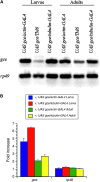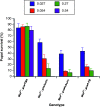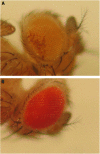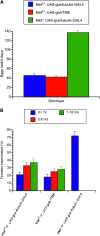Paralogous genes involved in juvenile hormone action in Drosophila melanogaster
- PMID: 20498297
- PMCID: PMC2927759
- DOI: 10.1534/genetics.110.116962
Paralogous genes involved in juvenile hormone action in Drosophila melanogaster
Abstract
Juvenile hormone (JH) is critical for multiple aspects of insect development and physiology. Although roles for the hormone have received considerable study, an understanding of the molecules necessary for JH action in insects has been frustratingly slow to evolve. Methoprene-tolerant (Met) in Drosophila melanogaster fulfills many of the requirements for a hormone receptor gene. A paralogous gene, germ-cell expressed (gce), possesses homology and is a candidate as a Met partner in JH action. Expression of gce was found to occur at multiple times and in multiple tissues during development, similar to that previously found for Met. To probe roles of this gene in JH action, we carried out in vivo gce over- and underexpression studies. We show by overexpression studies that gce can substitute in vivo for Met, alleviating preadult but not adult phenotypic characters. We also demonstrate that RNA interference-driven knockdown of gce expression in transgenic flies results in preadult lethality in the absence of MET. These results show that (1) unlike Met, gce is a vital gene and shows functional flexibility and (2) both gene products appear to promote JH action in preadult but not adult development.
Figures








Similar articles
-
Genetic Evidence for Function of the bHLH-PAS Protein Gce/Met As a Juvenile Hormone Receptor.PLoS Genet. 2015 Jul 10;11(7):e1005394. doi: 10.1371/journal.pgen.1005394. eCollection 2015 Jul. PLoS Genet. 2015. PMID: 26161662 Free PMC article.
-
Drosophila Met and Gce are partially redundant in transducing juvenile hormone action.Insect Biochem Mol Biol. 2011 Dec;41(12):938-45. doi: 10.1016/j.ibmb.2011.09.003. Epub 2011 Sep 29. Insect Biochem Mol Biol. 2011. PMID: 21968404
-
Genetic tools to study juvenile hormone action in Drosophila.Sci Rep. 2017 May 18;7(1):2132. doi: 10.1038/s41598-017-02264-4. Sci Rep. 2017. PMID: 28522854 Free PMC article.
-
The juvenile hormone signaling pathway in insect development.Annu Rev Entomol. 2013;58:181-204. doi: 10.1146/annurev-ento-120811-153700. Epub 2012 Sep 17. Annu Rev Entomol. 2013. PMID: 22994547 Review.
-
The juvenile hormone receptor as a target of juvenoid "insect growth regulators".Arch Insect Biochem Physiol. 2020 Mar;103(3):e21615. doi: 10.1002/arch.21615. Epub 2019 Sep 10. Arch Insect Biochem Physiol. 2020. PMID: 31502704 Review.
Cited by
-
Transcriptional regulation of juvenile hormone-mediated induction of Krüppel homolog 1, a repressor of insect metamorphosis.Proc Natl Acad Sci U S A. 2012 Jul 17;109(29):11729-34. doi: 10.1073/pnas.1204951109. Epub 2012 Jul 2. Proc Natl Acad Sci U S A. 2012. PMID: 22753472 Free PMC article.
-
Ligand-binding properties of a juvenile hormone receptor, Methoprene-tolerant.Proc Natl Acad Sci U S A. 2011 Dec 27;108(52):21128-33. doi: 10.1073/pnas.1116123109. Epub 2011 Dec 13. Proc Natl Acad Sci U S A. 2011. PMID: 22167806 Free PMC article.
-
Mechanisms regulating nutrition-dependent developmental plasticity through organ-specific effects in insects.Front Physiol. 2013 Sep 26;4:263. doi: 10.3389/fphys.2013.00263. Front Physiol. 2013. PMID: 24133450 Free PMC article. Review.
-
Genome-wide comparison of genes involved in the biosynthesis, metabolism, and signaling of juvenile hormone between silkworm and other insects.Genet Mol Biol. 2014 Jun;37(2):444-59. doi: 10.1590/s1415-47572014005000006. Genet Mol Biol. 2014. PMID: 25071411 Free PMC article.
-
Juvenile hormones direct primordial germ cell migration to the embryonic gonad.Curr Biol. 2024 Feb 5;34(3):505-518.e6. doi: 10.1016/j.cub.2023.12.033. Epub 2024 Jan 11. Curr Biol. 2024. PMID: 38215744 Free PMC article.
References
-
- Adam, G., N. Perrimon and S. Noselli, 2003. The retinoic-like juvenile hormone controls the looping of left-right asymmetric organs in Drosophila. Development 130 2397–2406. - PubMed
-
- Brand, A. H., and N. Perrimon, 1993. Targeted gene expression as a means of altering cell fates and generating dominant phenotypes. Development 118 401–415. - PubMed
Publication types
MeSH terms
Substances
Grants and funding
LinkOut - more resources
Full Text Sources
Molecular Biology Databases
Miscellaneous

